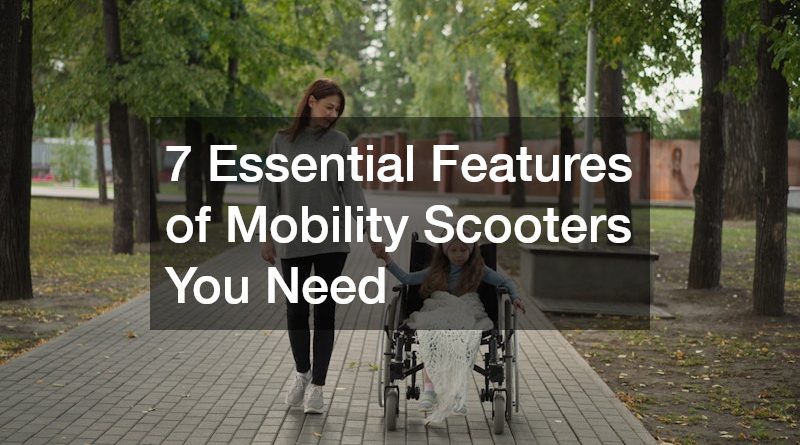7 Essential Features of Mobility Scooters You Need
Mobility scooters have transformed the lives of many Australians by restoring freedom and independence for those with limited mobility. Whether you are considering a scooter for yourself or a loved one, it is crucial to understand the essential features that ensure comfort, safety and usability. With a variety of models on the market, selecting the right mobility scooter can be overwhelming.
Focusing on the features that matter most will help you make an informed and practical decision.
1. Comfortable Seating for Long-Term Use
One of the most overlooked, yet critical, aspects of a mobility scooter is the quality of its seating. When spending extended periods sitting, a supportive, well-padded seat with adjustable settings can make a significant difference. Look for a scooter with a contoured seat that supports your back and hips, as well as adjustable armrests to accommodate different user sizes. Swivel seating can also provide convenience when transferring on or off the scooter. A higher-quality seat reduces the likelihood of pressure sores or discomfort, making it suitable for daily use.
2. Battery Life & Range
A dependable battery is fundamental for ensuring that your mobility scooter serves your daily needs without interruption. The battery life determines how far you can travel on a single charge, which is particularly important if you plan to use your scooter for errands, appointments or outings. Modern mobility scooters offer a range of travel distances, often between 10 to 50 kilometres depending on the battery capacity and terrain. Opting for a scooter with a lithium-ion battery can be advantageous, as they generally offer longer lifespan, faster charging times and lighter weight compared to traditional lead-acid batteries. Before making a purchase, consider your daily travel requirements and choose a model that comfortably accommodates your routine.
3. Maneuverability & Turning Radius
Maneuverability is a key factor in the usability of mobility scooters, especially in tight or crowded spaces. A scooter’s turning radius refers to the smallest circle it can make when turning. A smaller turning radius allows for better navigation indoors, such as in shopping centres or narrow hallways. Three-wheeled models tend to offer superior manoeuvrability due to their narrower front end, although four-wheeled scooters provide more stability on uneven terrain. Understanding where and how you will use the scooter most often will help determine the best configuration for your lifestyle.
4. Portability & Storage
If you travel frequently or have limited storage space at home, portability becomes an essential consideration. Some mobility scooters are designed to be easily disassembled into lighter components for storage in a car boot or confined area. Others may be foldable, offering convenience without the need for tools. When evaluating portability, take note of the total weight of the scooter and whether it fits your vehicle or storage area. Lightweight models are ideal for those who require flexibility, but they may sacrifice range or comfort. It’s important to strike a balance between portability and the essential features you cannot do without.
5. Safety Features & Stability
Safety should always be a top priority when selecting a mobility scooter. A stable and secure ride not only prevents accidents but also provides peace of mind. Anti-tip wheels, a low centre of gravity and reliable braking systems are all features that contribute to a safer experience. Additionally, many models now come equipped with headlights, reflectors and horns to enhance visibility and alert others, especially in crowded or low-light environments. Suspension systems can also improve ride comfort and stability, particularly on rough or uneven surfaces. Choosing a scooter that includes these features ensures that safety is never compromised.
6. Control System & Ease of Use
The control system of a mobility scooter should be intuitive and suited to the user’s physical capabilities. Most scooters utilise a tiller-style steering system with hand-operated throttle and brake controls. Ergonomically designed controls reduce strain on wrists and hands, making it easier for individuals with arthritis or limited dexterity to operate the scooter. Some advanced models offer digital displays, speed settings and programmable features, providing users with more control and personalisation. It’s advisable to test different models to find one that feels natural and easy to manage.
7. Weight Capacity & Build Quality
Durability and weight capacity are crucial, particularly for users with higher body weights or those who carry shopping or medical equipment. Always check the scooter’s maximum weight rating to ensure it supports your needs. Heavy-duty mobility scooters often feature reinforced frames, larger wheels and more powerful motors to accommodate additional load without sacrificing performance. The overall build quality also affects longevity and maintenance. Investing in a reputable brand with strong customer support and warranty options can save you time, money and frustration in the long run.
Regain Your Independence with the Right Mobility Scooter
Selecting the right mobility scooter is not just about comfort and convenience; it is about reclaiming independence and improving quality of life. By focusing on these seven essential features—seating, battery life, manoeuvrability, portability, safety, ease of use and durability—you can find a scooter that meets your daily needs and aligns with your lifestyle. Whether you are navigating local footpaths, running errands or simply enjoying the outdoors, mobility scooters provide a reliable and empowering solution for greater freedom and movement.
.

